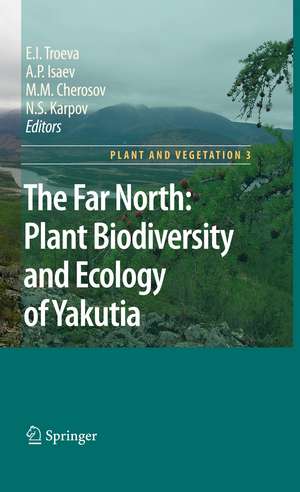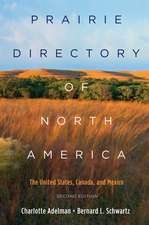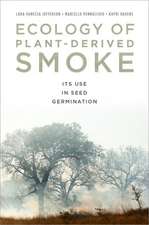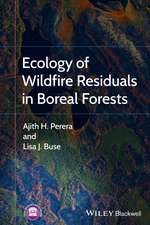The Far North:: Plant Biodiversity and Ecology of Yakutia: Plant and Vegetation, cartea 3
Editat de Elena I. Troeva, A. P. Isaev, M.M. Cherosov, N. S. Karpoven Limba Engleză Paperback – 28 mai 2012
| Toate formatele și edițiile | Preț | Express |
|---|---|---|
| Paperback (1) | 1222.01 lei 6-8 săpt. | |
| SPRINGER NETHERLANDS – 28 mai 2012 | 1222.01 lei 6-8 săpt. | |
| Hardback (1) | 1226.73 lei 6-8 săpt. | |
| SPRINGER NETHERLANDS – 8 apr 2010 | 1226.73 lei 6-8 săpt. |
Din seria Plant and Vegetation
- 18%
 Preț: 1125.86 lei
Preț: 1125.86 lei - 24%
 Preț: 802.94 lei
Preț: 802.94 lei - 18%
 Preț: 953.52 lei
Preț: 953.52 lei - 15%
 Preț: 642.83 lei
Preț: 642.83 lei - 18%
 Preț: 954.45 lei
Preț: 954.45 lei - 24%
 Preț: 1487.38 lei
Preț: 1487.38 lei - 24%
 Preț: 1329.23 lei
Preț: 1329.23 lei - 24%
 Preț: 962.68 lei
Preț: 962.68 lei - 18%
 Preț: 1405.09 lei
Preț: 1405.09 lei - 18%
 Preț: 1122.42 lei
Preț: 1122.42 lei - 24%
 Preț: 1049.70 lei
Preț: 1049.70 lei - 18%
 Preț: 1219.16 lei
Preț: 1219.16 lei - 18%
 Preț: 1378.10 lei
Preț: 1378.10 lei - 18%
 Preț: 1230.35 lei
Preț: 1230.35 lei - 18%
 Preț: 1221.38 lei
Preț: 1221.38 lei - 18%
 Preț: 966.78 lei
Preț: 966.78 lei - 18%
 Preț: 959.19 lei
Preț: 959.19 lei
Preț: 1222.01 lei
Preț vechi: 1490.25 lei
-18% Nou
Puncte Express: 1833
Preț estimativ în valută:
233.83€ • 254.79$ • 197.04£
233.83€ • 254.79$ • 197.04£
Carte tipărită la comandă
Livrare economică 23 aprilie-07 mai
Preluare comenzi: 021 569.72.76
Specificații
ISBN-13: 9789400731936
ISBN-10: 9400731930
Pagini: 408
Ilustrații: XV, 385 p.
Dimensiuni: 155 x 235 x 21 mm
Greutate: 0.57 kg
Ediția:2010
Editura: SPRINGER NETHERLANDS
Colecția Springer
Seria Plant and Vegetation
Locul publicării:Dordrecht, Netherlands
ISBN-10: 9400731930
Pagini: 408
Ilustrații: XV, 385 p.
Dimensiuni: 155 x 235 x 21 mm
Greutate: 0.57 kg
Ediția:2010
Editura: SPRINGER NETHERLANDS
Colecția Springer
Seria Plant and Vegetation
Locul publicării:Dordrecht, Netherlands
Public țintă
ResearchCuprins
Natural Conditions.- Flora of Yakutia: Composition and Ecological Structure.- Vegetation of Yakutia: Elements of Ecology and Plant Sociology.- Vegetation and Human Activity.- Insect Impact on Vegetation.- Structural and Functional Peculiarities of the Plants of Yakutia.- Nature Conservation Status and Its Prospects.
Textul de pe ultima copertă
Outside Russia very little is known about the terrestrial ecology, vegetation, biogeographical patterns, and biodiversity of the enormously extensive ecosystems of Yakutia, Siberia. These systems are very special in that they function on top of huge layers of permafrost and are exposed to very severe and extreme weather conditions, the range between winter and summer temperatures being more than 100 degrees C. The soils are generally poor, and human use of the vegetation is usually extensive. Main vegetation zones are taiga and tundra, but Yakutia also supports a special land and vegetation form, caused by permafrost, the alas: more or less extensive grasslands around roundish lakes in taiga. All these vegetation types will be described and their ecology and ecophysiological characteristics will be dealt with. Because of the size of Yakutia, covering several climatic zones, and its extreme position on ecological gradients, Yakutia contains very interesting biogeographical patterns, which also will be described. Our analyses are drawn from many years of research in Yakutia and from a vast body of ecological and other literature in Russian publications and in unpublished local reports. The anthropogenic influence on the ecosystems will be dealt with. This includes the main activities of human interference with nature: forestry, extensive reindeer herding, cattle and horse grazing, etc. Also fire and other prominent ecological factors are dealt with. A very important point is also the very high degree of naturalness that is still extant in Yakutia’s main vegetation zones.
Caracteristici
Totally unknown area in English speaking/reading world Ecology of areas with extreme climatic conditions Ecology of areas on huge depth of permafrost Ecology of a huge area that largely is still very natural Ecology of little-known land use practices (e.g. reindeer herding, 'alas' hay cutting)











